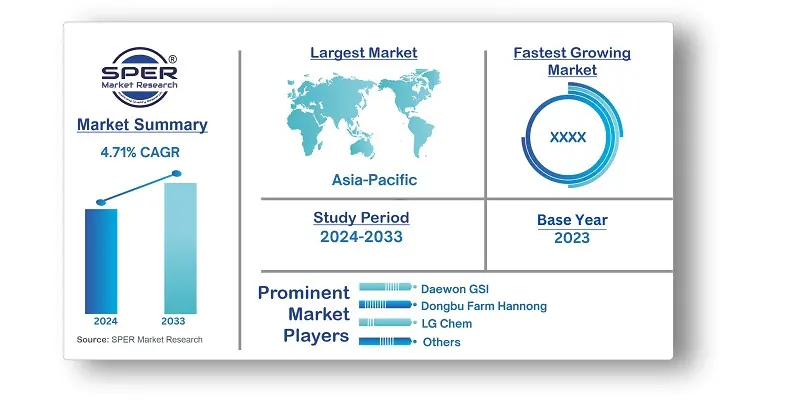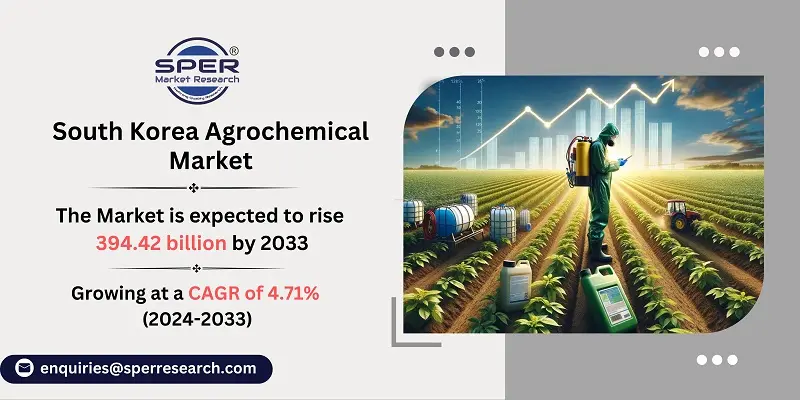
South Korea Agrochemicals Market Growth, Size, Trends, Demand, Revenue and Future Outlook
South Korea Agrochemicals Market Size- By Fertilizer Type, By Pesticide Type, By Crop Type- Regional Outlook, Competitive Strategies and Segment Forecast to 2033
| Published: Jul-2024 | Report ID: AGRI2430 | Pages: 1 - 103 | Formats*: |
| Category : Agriculture | |||
- June 2024; Companies like LG Chem and Dongbu Farm Hannong have been impacted by regulatory reforms established by authorities like Ministry of Agricultural, Food and Rural Affairs (MAFRA) with the goal of improving environmental sustainability. These reforms have pushed for the use of safer and more environmentally friendly agrochemical products.
- May 2024; Samyang Chemical and Namhae Chemical introduced biopesticides and due to their lower environmental impact as compared to conventional pesticides, these products are becoming more and more popular, which is in line with government and customer demands for environmentally friendly agricultural solutions.


| Report Metric | Details |
| Market size available for years | 2020-2033 |
| Base year considered | 2023 |
| Forecast period | 2024-2033 |
| Segments covered | By Fertilizer Type, By Pesticide Type, By Crop Type |
| Regions covered | Northern Region, Southern Region, Western Region, Eastern Region, Central Region |
| Companies Covered | Daewon GSI, Dongbu Farm Hannong, Farm Hannong, Hankook Shell Chemicals, Kyung Nong Corporation, LG Chem, Namhae Chemical, Korea Agro-Fisheries & Food Trade Corporation (aT), NongHyup Chemical, Samyang Chemical, Others. |
- Farmers and Agricultural Producers
- Agribusinesses and Agricultural Cooperatives
- Government Agencies and Regulatory Bodies
- Research Institutions and Academia
- Distributors and Retailers
- Environmental and Sustainability Groups
| By Fertilizer Type: |
|
| By Pesticide Type: |
|
| By Crop Type: |
|
- South Korea Agrochemicals Market Size (FY’2024-FY’2033)
- Overview of South Korea Agrochemicals Market
- Segmentation of South Korea Agrochemicals Market by Fertilizer Type (Nitrogen Fertilizer, Phosphatic Fertilizer, Potassic Fertilizer, Others)
- Segmentation of South Korea Agrochemicals Market by Pesticide Type (Fungicides, Herbicides, Insecticides, Others)
- Segmentation of South Korea Agrochemicals Market by Crop Type (Cereals and Grains, Oilseeds and Pulses, Fruits and Vegetables)
- Statistical Snap of South Korea Agrochemicals Market
- Expansion Analysis of South Korea Agrochemicals Market
- Problems and Obstacles in South Korea Agrochemicals Market
- Competitive Landscape in the South Korea Agrochemicals Market
- Impact of COVID-19 and Demonetization on South Korea Agrochemicals Market
- Details on Current Investment in South Korea Agrochemicals Market
- Competitive Analysis of South Korea Agrochemicals Market
- Prominent Players in the South Korea Agrochemicals Market
- SWOT Analysis of South Korea Agrochemicals Market
- South Korea Agrochemicals Market Future Outlook and Projections (FY’2024-FY’2033)
- Recommendations from Analyst
1.1. Scope of the report1.2. Market segment analysis
2.1. Research data source2.1.1. Secondary Data2.1.2. Primary Data2.1.3. SPER’s internal database2.1.4. Premium insight from KOL’s2.2. Market size estimation2.2.1. Top-down and Bottom-up approach2.3. Data triangulation
4.1. Driver, Restraint, Opportunity and Challenges analysis4.1.1. Drivers4.1.2. Restraints4.1.3. Opportunities4.1.4. Challenges4.2. COVID-19 Impacts of the South Korea Agrochemicals Market.
5.1. SWOT Analysis5.1.1. Strengths5.1.2. Weaknesses5.1.3. Opportunities5.1.4. Threats5.2. PESTEL Analysis5.2.1. Political Landscape5.2.2. Economic Landscape5.2.3. Social Landscape5.2.4. Technological Landscape5.2.5. Environmental Landscape5.2.6. Legal Landscape5.3. PORTER’s Five Forces5.3.1. Bargaining power of suppliers5.3.2. Bargaining power of buyers5.3.3. Threat of Substitute5.3.4. Threat of new entrant5.3.5. Competitive rivalry5.4. Heat Map Analysis
6.1. South Korea Agrochemicals Market Manufacturing Base Distribution, Sales Area, Product Type6.2. Mergers & Acquisitions, Partnerships, Product Launch, and Collaboration in South Korea Agrochemicals Market
7.1. South Korea Agrochemicals Market Size, Share and Forecast, By Fertilizer Type, 2020-20267.2. South Korea Agrochemicals Market Size, Share and Forecast, By Fertilizer Type, 2027-20337.3. Nitrogen Fertilizer7.4. Phosphatic Fertilizer7.5. Potassic Fertilizer7.6. Others
8.1. South Korea Agrochemicals Market Size, Share and Forecast, By Pesticide Type, 2020-20268.2. South Korea Agrochemicals Market Size, Share and Forecast, By Pesticide Type, 2027-20338.3. Fungicides8.4. Herbicides8.5. Insecticides8.6. Others
9.1. South Korea Agrochemicals Market Size, Share and Forecast, By Crop Type, 2020-20269.2. South Korea Agrochemicals Market Size, Share and Forecast, By Crop Type, 2027-20339.3. Cereals and Grains9.4. Oilseeds and Pulses9.5. Fruits and Vegetables
10.1. South Korea Agrochemicals Market Size and Market Share
11.1. South Korea Agrochemicals Market Size and Market Share By Region (2020-2026)11.2. South Korea Agrochemicals Market Size and Market Share By Region (2027-2033)11.3. Northern Region11.4. Southern Region11.5. Western Region11.6. Eastern Region11.7. Southern Region
12.1. DAEWON GSI12.1.1. Company details12.1.2. Financial outlook12.1.3. Product summary12.1.4. Recent developments12.2. DONGBU FARM HANNONG12.2.1. Company details12.2.2. Financial outlook12.2.3. Product summary12.2.4. Recent developments12.3. KOREA AGRO FISHERIES AND FOOD TRADE CORPORATION12.3.1. Company details12.3.2. Financial outlook12.3.3. Product summary12.3.4. Recent developments12.4. KYUNG NONG CORPORATION12.4.1. Company details12.4.2. Financial outlook12.4.3. Product summary12.4.4. Recent developments12.5. LG CHEM12.5.1. Company details12.5.2. Financial outlook12.5.3. Product summary12.5.4. Recent developments12.6. LG CHEM12.6.1. Company details12.6.2. Financial outlook12.6.3. Product summary12.6.4. Recent developments12.7. NAMHAE CHEMICAL12.7.1. Company details12.7.2. Financial outlook12.7.3. Product summary12.7.4. Recent developments12.8. NONGHYUP CHEMICAL12.8.1. Company details12.8.2. Financial outlook12.8.3. Product summary12.8.4. Recent developments12.9. SAMYANG CHEMICAL12.9.1. Company details12.9.2. Financial outlook12.9.3. Product summary12.9.4. Recent developments12.10. Others
SPER Market Research’s methodology uses great emphasis on primary research to ensure that the market intelligence insights are up to date, reliable and accurate. Primary interviews are done with players involved in each phase of a supply chain to analyze the market forecasting. The secondary research method is used to help you fully understand how the future markets and the spending patterns look likes.
The report is based on in-depth qualitative and quantitative analysis of the Product Market. The quantitative analysis involves the application of various projection and sampling techniques. The qualitative analysis involves primary interviews, surveys, and vendor briefings. The data gathered as a result of these processes are validated through experts opinion. Our research methodology entails an ideal mixture of primary and secondary initiatives.



Frequently Asked Questions About This Report
PLACE AN ORDER
Year End Discount
Sample Report
Pre-Purchase Inquiry
NEED CUSTOMIZATION?
Request CustomizationCALL OR EMAIL US
100% Secure Payment






Related Reports
Our Global Clients
Our data-driven insights have influenced the strategy of 200+ reputed companies across the globe.




















